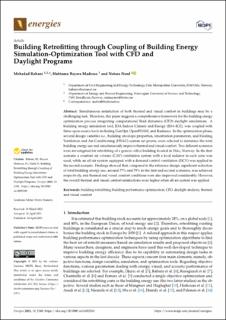Building Retrofitting through Coupling of Building Energy Simulation-Optimization Tool with CFD and Daylight Programs
| dc.contributor.author | Rabani, Mehrdad | |
| dc.contributor.author | Madessa, Habtamu Bayera | |
| dc.contributor.author | Nord, Natasa | |
| dc.coverage.spatial | Oslo, Norway | en_US |
| dc.date.accessioned | 2021-05-10T13:53:45Z | |
| dc.date.available | 2021-05-10T13:53:45Z | |
| dc.date.created | 2021-05-07T23:21:54Z | |
| dc.date.issued | 2021-04-14 | |
| dc.identifier.issn | 1996-1073 | |
| dc.identifier.uri | https://hdl.handle.net/11250/2754736 | |
| dc.description.abstract | Simultaneous satisfaction of both thermal and visual comfort in buildings may be a challenging task. Therefore, this paper suggests a comprehensive framework for the building energy optimization process integrating computational fluid dynamics (CFD) daylight simulations. A building energy simulation tool, IDA Indoor Climate and Energy (IDA-ICE), was coupled with three open-source tools including GenOpt, OpenFOAM, and Radiance. In the optimization phase, several design variables i.e., building envelope properties, fenestration parameters, and Heating, Ventilation and Air-Conditioning (HVAC) system set points, were selected to minimize the total building energy use and simultaneously improve thermal and visual comfort. Two different scenarios were investigated for retrofitting of a generic office building located in Oslo, Norway. In the first scenario a constant air volume (CAV) ventilation system with a local radiator in each zone was used, while an all-air system equipped with a demand control ventilation (DCV) was applied in the second scenario. Findings showed that, compared to the reference design, significant reduction of total building energy use, around 77% and 79% in the first and second scenarios, was achieved respectively, and thermal and visual comfort conditions were also improved considerably. However, the overall thermal and visual comfort satisfactions were higher when all-air system was applied. | en_US |
| dc.language.iso | eng | en_US |
| dc.publisher | MDPI | en_US |
| dc.relation.ispartofseries | Energies;Volume 14, Issue 8 | |
| dc.rights | Navngivelse 4.0 Internasjonal | * |
| dc.rights.uri | http://creativecommons.org/licenses/by/4.0/deed.no | * |
| dc.subject | Building retrofitting | en_US |
| dc.subject | Building performance optimization | en_US |
| dc.subject | Computational fluid dynamics | en_US |
| dc.subject | CFD | en_US |
| dc.subject | Daylight analyses | en_US |
| dc.subject | Thermal comfort | en_US |
| dc.subject | Visual comfort | en_US |
| dc.title | Building Retrofitting through Coupling of Building Energy Simulation-Optimization Tool with CFD and Daylight Programs | en_US |
| dc.type | Peer reviewed | en_US |
| dc.type | Journal article | en_US |
| dc.description.version | publishedVersion | en_US |
| dc.rights.holder | © 2021 by the authors. | en_US |
| dc.source.articlenumber | 2180 | en_US |
| cristin.ispublished | true | |
| cristin.fulltext | original | |
| cristin.qualitycode | 1 | |
| dc.identifier.doi | https://doi.org/10.3390/ en14082180 | |
| dc.identifier.cristin | 1908886 | |
| dc.source.journal | Energies | en_US |
| dc.source.volume | 14 | en_US |
| dc.source.issue | 8 | en_US |
| dc.source.pagenumber | 23 | en_US |
Tilhørende fil(er)
Denne innførselen finnes i følgende samling(er)
-
Publikasjoner fra Cristin [3269]
-
TKD - Institutt for bygg- og energiteknikk [416]
TKD - Department of Built Environment

